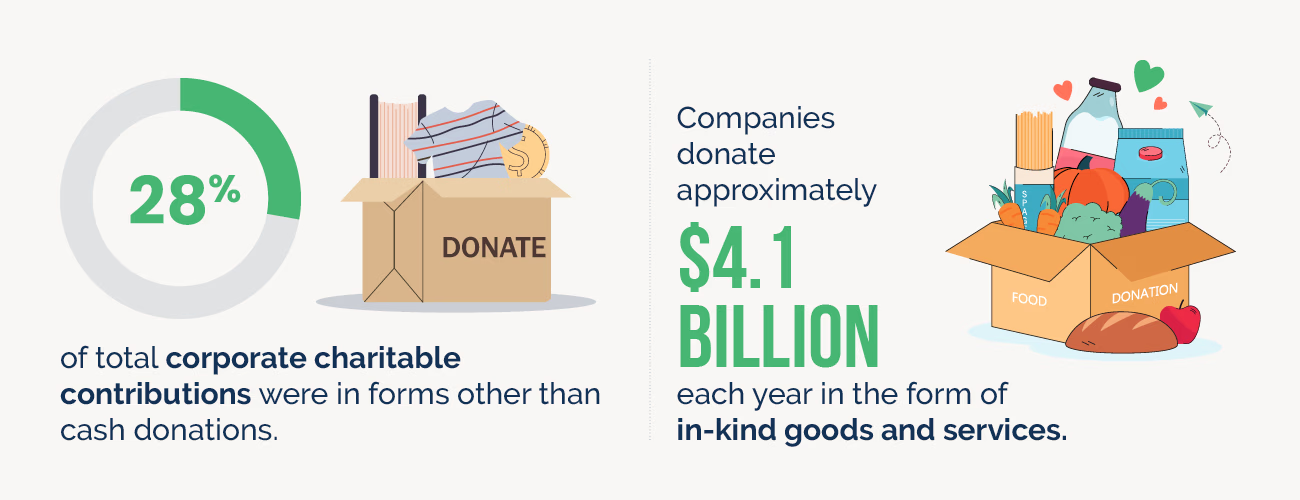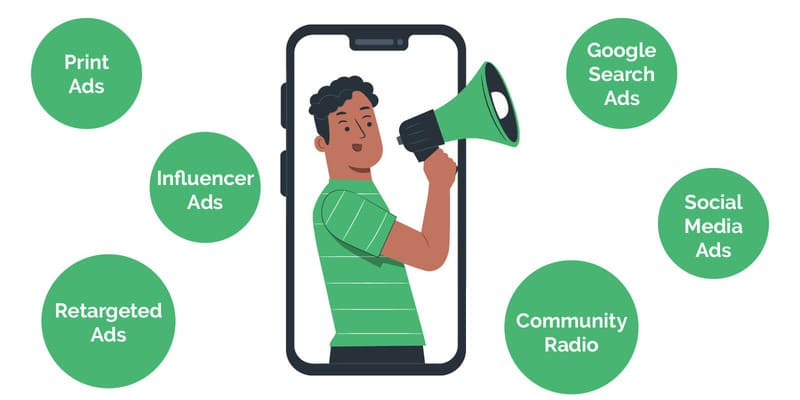Nonprofits know how crucial marketing is for acquiring supporters, earning donations, and fulfilling their missions. But these organizations also often have tight budgets and limited staff time. Sometimes, you just need extra support to effectively promote your cause—and that’s where sponsorships come in.
Corporate sponsorships offer nonprofits the opportunity to gain both financial and marketing support that can propel their efforts forward significantly. To secure these valuable partnerships, nonprofits must identify the right sponsors, clearly communicate their mission and needs, and present a compelling case for why a sponsorship benefits both the organization and the sponsor.
By strategically leveraging corporate sponsorships, you can boost visibility, strengthen your cause, and enhance your nonprofit’s ability to succeed. Let’s discuss how to find, secure, and leverage these opportunities.
What Are Corporate Sponsorships?
Corporate sponsorships are an important aspect of corporate social responsibility (CSR), where businesses support nonprofits to enhance their reputation, engage with customers and employees, and demonstrate their commitment to social causes. Companies typically develop philanthropic programs to partner with nonprofits in a variety of ways. These partnerships can range from sponsoring specific events or projects to providing matching donations or assisting in raising awareness for fundraising campaigns.
When sponsoring a nonprofit, companies will provide direct support to that individual organization. This support can take many forms, including:
- Financial: A business may provide monetary support for a major event or donate a grant to fund specific needs, such as purchasing new technology or expanding your nonprofit’s reach. This could also include matching donations during a fundraiser to help increase the total raised.
- In-kind: In-kind sponsorships involve businesses donating goods or services instead of money. These can include tangible assets such as equipment, venue space, or auction items for events. However, they can also encompass professional services, such as event planning, catering, or web design, and other non-monetary contributions, like offering volunteers, transportation, or office supplies.
- Media: Many companies choose to sponsor a nonprofit through marketing and media efforts. This could include funding your marketing campaign, donating advertising space in print, radio, or online platforms, or providing pro-bono services like social media management, graphic design, or video production.
Successful corporate sponsorships benefit both parties—companies get a reputation boost and positive brand awareness, and your nonprofit receives funding and access to a wider audience.
How to Find and Secure Sponsorships
While sponsorships sound ideal, you may be wondering: Are many companies interested in sponsoring nonprofits? Will you be able to find and secure one for your organization?
The good news is that companies love philanthropy, and giving back in new and exciting ways. Double the Donation statistics report that 28% of corporate charitable contributions were in forms other than cash donations. In fact, companies donate approximately $4.1 billion each year in the form of in-kind goods and services!

To find and secure a corporate sponsorship for your nonprofit, follow these steps:
- Start with existing relationships. First, consider companies you’ve partnered with before, including donors, volunteers, and board members who may have connections to local businesses or larger corporations. Often, these existing relationships can open doors for sponsorship opportunities. For example, your donors might work for employers who are open to supporting charitable causes, so don’t hesitate to ask them if their companies would be interested in a partnership. Any relationship you already have with a business will help you make a good case for a sponsorship when it comes time to make the ask.
- Research potential sponsors. Look for local businesses and larger companies with shared interests or values that may align with your mission. For instance, a soup kitchen might seek out local restaurants. Meanwhile, larger companies often have corporate social responsibility programs where they regularly sponsor nonprofits, and a CSR database can help you find these opportunities. Many companies also have grant programs that are open for applications. Once you have a short list, do more research to find things you have in common, such as charitable interests or goals. Then, check their website to see if they’ve sponsored similar nonprofits before.
- Prepare a pitch. Draft a pitch that outlines why the company should sponsor you and what a sponsorship would entail. Explain your mission, detail how your work lines up with their company values, and highlight any existing connections, such as employees who are already involved with your nonprofit. Some sponsors may require a formal pitch, while others may use a standardized application process, especially large corporations with open-application grant programs. Be prepared to adapt your approach based on the sponsor’s preferences.
Remember to reiterate the benefits for businesses when you make your pitch, like the positive reputation boost they’re likely to receive. Once you secure a partnership, whether with a small business or a large corporation, work closely to finalize the details of the sponsorship. With smaller businesses, you’ll likely collaborate more directly to establish the terms. However, many large corporations will have a set of formal guidelines that nonprofits must follow to remain eligible for ongoing or future support. Make sure you are clear on these rules when applying for funding or finalizing sponsorship agreements to ensure a lasting and successful partnership.
Tips for Using Corporate Sponsorships to Market Your Mission
After securing a sponsorship, you can get to work leveraging it to promote your cause! While marketing your mission may look different depending on the type of sponsorship you receive, these basic tips should help.
Communicate Your Mission
Whether your sponsor donates marketing services or just provides a platform for you to promote your organization yourself, it’s crucial to communicate your mission accurately and effectively.
To do so, consider:
- Creating a brand guide for your nonprofit that outlines how to talk about your mission, including any phrases or topics that should be avoided. This will also help you maintain consistency across your marketing materials, boosting brand recognition across channels.
- Incorporating impact stories that bring a human element to your content and give your audience a clear idea of the impact you create. Use real stories of your beneficiaries, donors, or volunteers that demonstrate your mission in action, and include concrete details to bring the stories to life.
- Implementing effective grant writing practices. Some corporate sponsorships may require nonprofits to submit a grant proposal. When drafting such documentation, frame your mission and needs in a way that aligns with the sponsor’s philanthropic goals. Research their past initiatives to identify how your mission complements their values and objectives. This can increase the likelihood of securing support.
By having a solid brand guide, impact stories, and a structured grant writing process in place, you’ll streamline the sponsorship outreach and application process. This will help you secure more sponsorships without overwhelming your team, allowing your nonprofit to focus on fulfilling its mission while fostering strong partnerships with sponsors.
Maximize the Extra Media Exposure
No matter what the details of your sponsorship are, you’ll gain increased media exposure just by partnering with a business. When they promote your event or campaign website, you’ll get access to a new audience of potential supporters. This is especially true if you secure a corporate sponsor whose audience is already interested in similar causes to your own!
Plus, you may be able to access new marketing channels with your sponsor’s support. These might even include paid advertisements like:

- Print ads
- Influencer ads
- Retargeted ads
- Google ads
- Social media ads
- Community radio ads
As you develop marketing materials for these new channels and audiences, maximize the expanded reach by tailoring your content to the interests of your sponsor’s audience. Lean on values that your nonprofit and the company have in common, and present your cause in ways that would appeal to the business’s customers.
For example, say that your nonprofit works toward marine life conservation and your sponsor is a sustainable clothing company. In this case, you’d want to lean into customers’ interest in sustainability and explain how they can make even more of a difference on the environment by donating to your nonprofit.
Any kind of corporate sponsorship can broaden your nonprofit’s reach and allow you to get your mission in front of more people. But when you choose the right business to partner with and thoughtfully plan out your marketing strategies, you and your corporate sponsor can achieve great things together.
About the Author: Adam Weinger is the President of Double the Donation, the leading provider of matching gift and workplace giving tools to nonprofit organizations and educational institutions. Adam created Double the Donation in order to help organizations increase their annual revenue through these workplace giving programs.
We believe it should be easy for fundraisers to grow mission support by offering supporters actionable next steps for harnessing workplace giving programs. That’s why our robust database of workplace giving programs and our native platform integrations enable fundraisers to pursue matching gifts, volunteer grants, and other workplace giving programs with less effort and more confidence.
Read More
By: Guest Author
Title: How to Secure Corporate Sponsorships & Market Your Mission
Sourced From: marketinginsidergroup.com/marketing-strategy/how-to-secure-corporate-sponsorships-market-your-mission/
Published Date: Fri, 03 Oct 2025 09:30:20 +0000
Did you miss our previous article...
https://trendinginbusiness.business/business/sir-jim-ratcliffes-bust-by-christmas-warning-questioned-after-36m-jobs-cull-at-manchester-united
.png)





